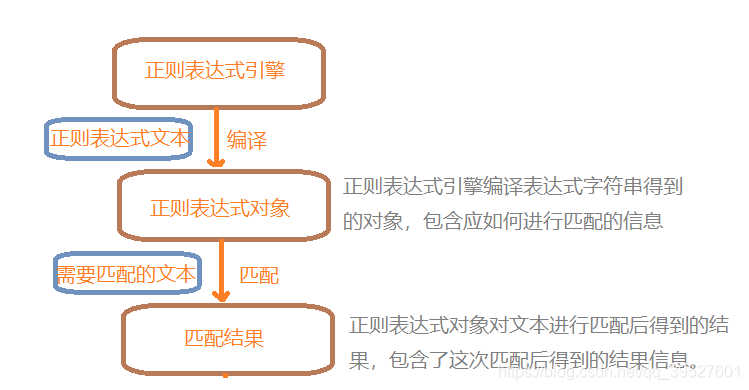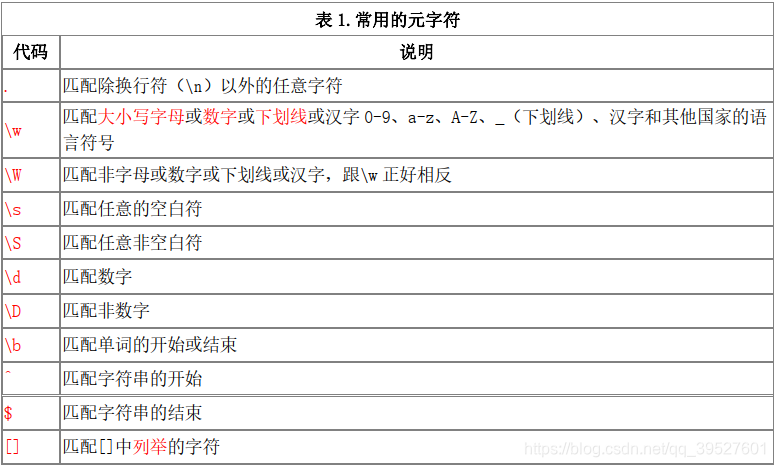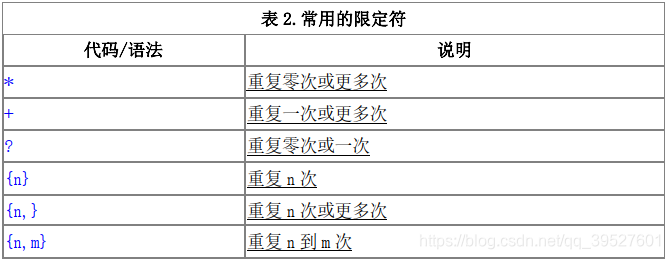1、什么是正则表达式?
正则表达式也叫做模式匹配,它是由一组特定含义的字符串组成,通常用于匹配和替换文本。
正则表达式并不是Python的一部分。它拥有自己独特的语法和独立的引擎。
2、为什么要使用正则表达式?
简化开发过程中的复杂度和提高开发效率。
3、正则表达式的匹配流程:
依次拿出表达式和文本中的字符比较,如果每一个字符都能匹配,则匹配成功;一档匹配到不成功的字符串,则匹配失败。

4、python为了方便对正则的使用,引入了re模块:
re模块提供对正则表达式的支持。re模块提供了与这些方法功能完全一致的函数,这些函数使用一个模式字符串作为他们的第一个参数。
>>> import re
>>> dir(re)
['A', 'ASCII', 'DEBUG', 'DOTALL', 'I', 'IGNORECASE', 'L', 'LOCALE', 'M', 'MULTILINE', 'RegexFlag', 'S', 'Scanner', 'T', 'TEMPLATE', 'U', 'UNICODE', 'VERBOSE', 'X', '_MAXCACHE', '__all__', '__builtins__', '__cached__', '__doc__', '__file__', '__loader__', '__name__', '__package__', '__spec__', '__version__', '_alphanum_bytes', '_alphanum_str', '_cache', '_compile', '_compile_repl', '_expand', '_locale', '_pattern_type', '_pickle', '_subx', 'compile', 'copyreg', 'enum', 'error', 'escape', 'findall', 'finditer', 'fullmatch', 'functools', 'match', 'purge', 'search', 'split', 'sre_compile', 'sre_parse', 'sub', 'subn', 'template']
- re.match()尝试从字符串的起始位置匹配一个模式,如果不是起始位置匹配成功的话,match()则返回None
match(pattern, string, flags=0)
Try to apply the pattern at the start of the string, returning
a match object, or None if no match was found.
我们可以使用group(num)或groups()匹配对象函数来获取匹配表达式。
>>> match=re.match("www","www.baidu.com")
>>> match.group()
'www'
- re.search()扫描整个字符串并返回第一个成功的匹配。
search(pattern, string, flags=0)
Scan through string looking for a match to the pattern, returning
a match object, or None if no match was found.
>>> match=re.search("www","www.baidu.com.www")
>>> match.group()
'www'
search()和match的区别:
match只匹配字符串的开始,如果字符串开始不符合正则表达式,则匹配失败,返回None。
search匹配整个字符串知道找到一个匹配。
>>> re.match("www","baidu.com.www")
>>> re.search("www","baidu.com.www")
<_sre.SRE_Match object; span=(10, 13), match='www'>
- sub()用于替换字符串中的匹配项。
sub(pattern, repl, string, count=0, flags=0)
参数:
pattern : 正则中的模式字符串。
repl : 替换的字符串,也可为一个函数。
string : 要被查找替换的原始字符串。
count : 模式匹配后替换的最大次数,默认 0 表示替换所有的匹配。
flags : 编译时用的匹配模式,数字形式。
前三个为必选参数,后两个为可选参数。
例:
>>> re.sub("#","","87+13498727431 #这是一个电话号码")
'87+13498727431 这是一个电话号码'
- compile()用于编译正则表达式,生成一个正则表达式(pattern)对象,供match()和search()使用。
compile(pattern, flags=0)
Compile a regular expression pattern, returning a pattern object.
- findall()找到正则表达式所匹配的所有字符串,并返回一个列表,如果没有找到,则返回空列表。
match()和search()是匹配一次,findall()是匹配所有。
findall(pattern, string, flags=0)
Return a list of all non-overlapping matches in the string.
If one or more capturing groups are present in the pattern, return
a list of groups; this will be a list of tuples if the pattern
has more than one group.
Empty matches are included in the result.
- finditer()在字符串中找到正则表达式所匹配的所有字符串,并把它们作为一个迭代器返回。
finditer(pattern, string, flags=0)
Return an iterator over all non-overlapping matches in the
string. For each match, the iterator returns a match object.
Empty matches are included in the result.
- re.split()按照能够匹配的字符串将字符串分割后返回列表
split(pattern, string, maxsplit=0, flags=0)
参数:
pattern # 匹配的正则表达式
string # 要匹配的字符串。
maxsplit # 分隔次数,maxsplit=1 分隔一次,默认为 0,不限制次数。
flags # 标志位,用于控制正则表达式的匹配方式,如:是否区分大小写,多行匹配等等。
5、元字符

- \w与\W
>>> re.match("\w","0xad29c320") #字符串第一个字符是否为有效字符
<_sre.SRE_Match object; span=(0, 1), match='0'>
>>> re.match("\w","+0xad29c320")
>>> re.match("\W","+0xad29c320") #字符串第一个字符是非有效字符,与\w正好相反
<_sre.SRE_Match object; span=(0, 1), match='+'>
- \s与\S
>>> re.match("\s"," hello python")
<_sre.SRE_Match object; span=(0, 1), match=' '>
>>> re.match("\S"," hello python")
- \d与\D
>>> re.match("\d","my age is 13")
>>> re.match("\D","my age is 13")
<_sre.SRE_Match object; span=(0, 1), match='m'>
>>> re.match("\d","2019年是建国70周年") #\d代表匹配一个数字
<_sre.SRE_Match object; span=(0, 1), match='2'>
>>> re.match("\d\d","2019年是建国70周年")
<_sre.SRE_Match object; span=(0, 2), match='20'>
>>> re.findall("\d","2019年是建国70周年")
['2', '0', '1', '9', '7', '0']
- ^与$
>>> re.match("^i am","i am zhang") #以i am开头
<_sre.SRE_Match object; span=(0, 4), match='i am'>
>>> re.match(".*g$","i am zhang") #以g结尾
<_sre.SRE_Match object; span=(0, 10), match='i am zhang'>
>>> re.match("^i am.*g$","i am zhang") #以i am开头,并且以g结尾
<_sre.SRE_Match object; span=(0, 10), match='i am zhang'>
- []
>>> re.match("[0-9]","0xa543cbf0") #匹配是否以数字开头
<_sre.SRE_Match object; span=(0, 1), match='0'>
6、字符转义
比如你要查找.,或者*,就会出现问题,因为.和*是有特殊含义的,他们会被解释成其他意思,这是就需要\来取消这些字符的特殊意义。例如:\.和\*,当然要查找\本身就需要用\\来表示。
>>> re.match("c:\\","c:\\a\\b") #错误,因为\\转义后就变成了\
>>> re.match("c:\\\\","c:\\a\\b") #正确,
<_sre.SRE_Match object; span=(0, 3), match='c:\\'>
>>> re.match(r"c:\\","c:\\a\\b") #正确,r表示匹配的字符不进行转义
<_sre.SRE_Match object; span=(0, 3), match='c:\\'>
7、重复

例:
# + #匹配一到多个
例:
>>> re.findall("\d+","我今年0岁,马上出生就是1岁")
['0', '1']
# ? #匹配0到1个
# {m} # 表示m位
例:
>>> re.findall("\d{4}","我今年0岁,马上出生就是1岁,今年是2019年,建国70周年了")
['2019']
# {m,} #表示至少m位
例:
>>> re.findall(r"\d{2,}","我今年0岁,马上出生就是1岁,今年是2019年,建国70周年了")
['2019', '70']
# {m,n} #最少m位,最多n位
例:
>>> re.findall(r"\d{1,4}","我今年0岁,马上出生就是1岁,今年是2019年,建国70周年了")
['0', '1', '2019', '70']
练习:匹配是否为电话号码:
>>> re.match(r"^1[3456789]\d{9}","13457824875")
<_sre.SRE_Match object; span=(0, 11), match='13457824875'>
练习:匹配出python的邮箱,且@之前有4到20个字符,如:123456@python.com>>>
re.findall("\w{4,20}@python.com$","zhang_0@python.com")
['zhang_0@python.com']
>>> re.findall("\w{4,20}@python.com$","zha@python.com")
[]





 本文深入解析正则表达式的概念、使用场景及Python中re模块的高级应用,包括match、search、findall等函数详解,助您快速掌握文本处理技巧。
本文深入解析正则表达式的概念、使用场景及Python中re模块的高级应用,包括match、search、findall等函数详解,助您快速掌握文本处理技巧。
















 1892
1892

 被折叠的 条评论
为什么被折叠?
被折叠的 条评论
为什么被折叠?








